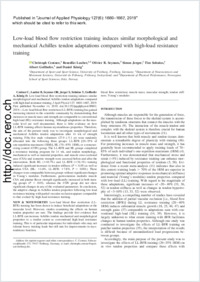Low-load blood flow restriction training induces similar morphological and mechanical Achilles tendon adaptations compared with high-load resistance training
- Centner, Christoph Department of Sport and Sport Science, University of Freiburg, Freiburg, Germany
- Lauber, Benedikt Department of Sport and Sport Science, University of Freiburg, Freiburg, Germany - Department of Neurosciences and Movement Sciences, Université de Fribourg, Fribourg, Switzerland
- Seynnes, Olivier R. Department of Physical Performance, Norwegian School of Sport Sciences, Oslo, Norway
- Jerger, Simon Department of Sport and Sport Science, University of Freiburg, Freiburg, Germany
- Sohnius, Tim Department of Sport and Sport Science, University of Freiburg, Freiburg, Germany
- Gollhofer, Albert Department of Sport and Sport Science, University of Freiburg, Freiburg, Germany
- König, Daniel Department of Sport and Sport Science, University of Freiburg, Freiburg, Germany
-
14.11.2019
Published in:
- Journal of Applied Physiology. - 2019, vol. 127, no. 6, p. 1660–1667
English
ow-load blood flow restriction (LL-BFR) training has gained increasing interest in the scientific community by demonstrating that increases in muscle mass and strength are comparable to conventional high-load (HL) resistance training. Although adaptations on the muscular level are well documented, there is little evidence on how LL-BFR training affects human myotendinous properties. Therefore, the aim of the present study was to investigate morphological and mechanical Achilles tendon adaptations after 14 wk of strength training. Fifty-five male volunteers (27.9 ± 5.1 yr) were randomly allocated into the following three groups: LL-BFR [20–35% of one-repetition maximum (1RM)], HL (70–85% 1RM), or a nonexercising control (CON) group. The LL-BFR and HL groups completed a resistance training program for 14 wk, and tendon morphology, mechanical as well as material properties, and muscle cross- sectional area (CSA) and isometric strength were assessed before and after the intervention. Both HL (+40.7%) and LL-BFR (+36.1%) training induced significant increases in tendon stiffness (P < 0.05) as well as tendon CSA (HL: +4.6%, LL-BFR: +7.8%, P < 0.001). These changes were comparable between groups without significant changes in Young’s modulus. Furthermore, gastrocnemius medialis muscle CSA and plantar flexor strength significantly increased in both training groups (P < 0.05), whereas the CON group did not show significant changes in any of the evaluated parameters. In conclusion, the adaptive change in Achilles tendon properties following low-load resistance training with partial vascular occlusion appears comparable to that evoked by high-load resistance training.NEW & NOTEWORTHY Low-load blood flow restriction (LL-BFR) training has been shown to induce beneficial adaptations at the muscular level. However, studies examining the effects on human tendon properties are rare. The findings provide first evidence that LL-BFR can increase Achilles tendon mechanical and morphological properties to a similar extent as conventional high-load resistance training. This is of particular importance for individuals who may not tolerate heavy training loads but still aim for improvements in myotendinous function.
- Faculty
- Faculté des sciences et de médecine
- Department
- Département de Médecine
- Language
-
- English
- Classification
- Sports sciences
- License
- License undefined
- Identifiers
-
- RERO DOC 328016
- DOI 10.1152/japplphysiol.00602.2019
- Persistent URL
- https://folia.unifr.ch/unifr/documents/308336
Statistics
Document views: 104
File downloads:
- koe_llb.pdf: 362
